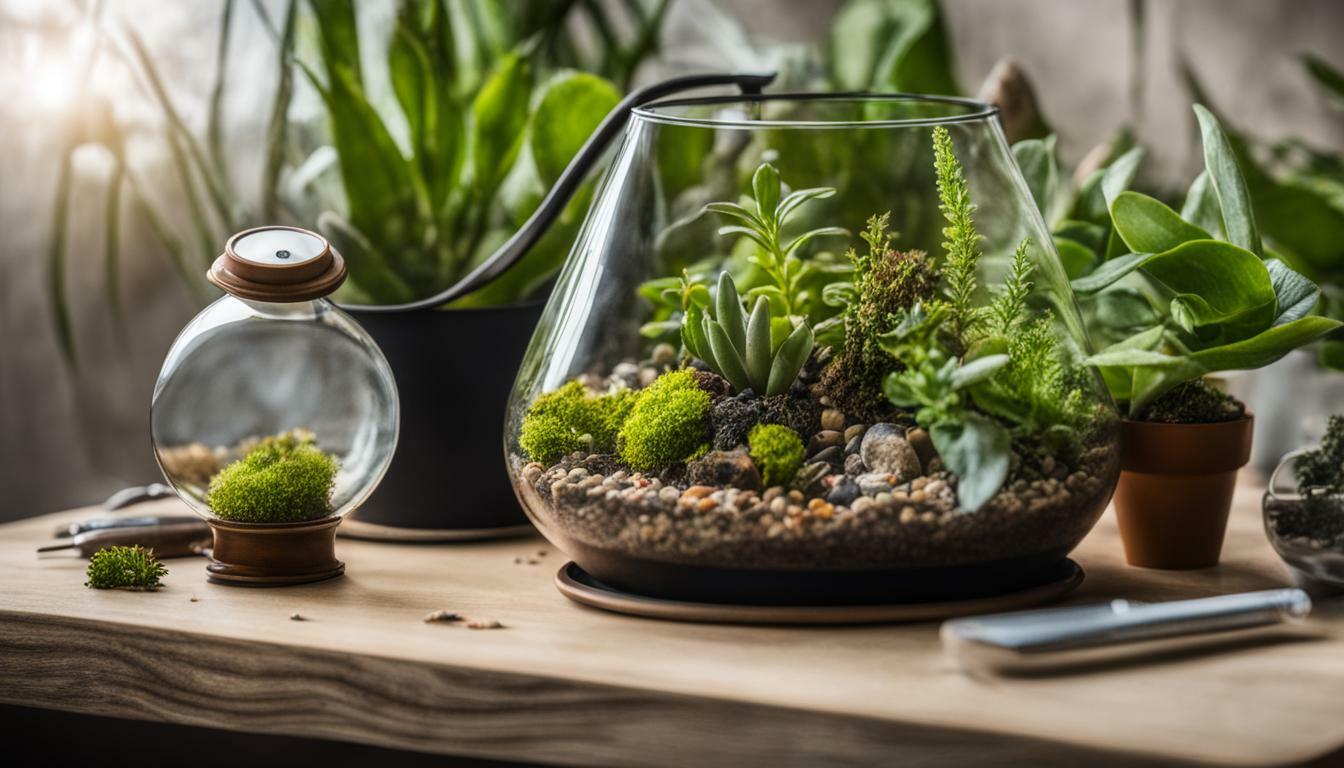Welcome to our Master Terrarium Care: Troubleshooting Plant Issues Guide. Terrariums are a wonderful way to bring the beauty of nature indoors, but like any living ecosystem, they require proper care and maintenance to thrive. In this comprehensive guide, we will delve into the world of terrarium care, offering troubleshooting tips for common plant issues. Whether you’re new to terrariums or a seasoned enthusiast, this guide will provide valuable insights to help you create and sustain a healthy mini garden.
- Understanding the basics of terrarium care is essential for maintaining a healthy ecosystem.
- Proper lighting and placement are crucial factors that influence plant health in a terrarium.
- Cleaning and watering routines are vital for maintaining pristine terrarium conditions.
- Choosing the right plants for your terrarium is essential for long-term success.
- Regulating humidity and moisture levels is key to preventing common plant health problems.
Understanding Terrarium Care Basics
To effectively troubleshoot plant issues in your terrarium, it’s crucial to have a solid foundation in terrarium care. Terrariums are unique mini ecosystems that require specific care to thrive. Here are some essential terrarium care tips to help you maintain a healthy and vibrant environment for your plants.
Lighting and Placement
Proper lighting is vital for plant health in a terrarium. Most terrarium plants prefer indirect or filtered light. Avoid placing your terrarium in direct sunlight, as the glass can act as a magnifying lens and burn the plants. If your terrarium is not receiving enough light, consider using grow lights or moving it closer to an indirect light source.
Cleaning and Watering
Maintaining cleanliness and proper watering practices are essential for the health of your terrarium. Clean the glass of the terrarium inside and out to allow sufficient light to reach the plants. When watering, use a spray bottle to mist the plants and soil, ensuring you do not overwater. If you notice excess water pooling in the terrarium, absorb it with a paper towel to prevent root rot.
Plant Selection
Selecting the right plants for your terrarium is crucial. Choose plants that thrive in the type of terrarium you have and have similar light and moisture requirements. Avoid planting succulents in closed terrariums as the high humidity can be detrimental to their growth. Consider the size and growth habit of the plants, as overcrowding can lead to competition for light and resources.
By following these terrarium care tips, you can create a healthy and thriving environment for your plants. In the next section, we will explore the importance of lighting and placement in more detail, providing troubleshooting tips for common lighting and placement issues. Stay tuned!
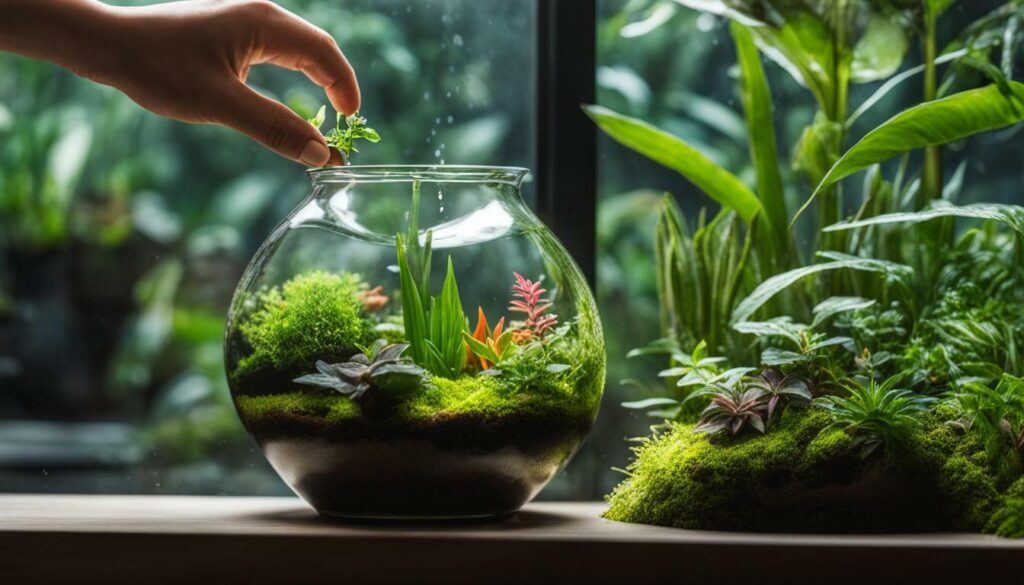 .
.Lighting and placement play a crucial role in the overall health and well-being of your terrarium plants. Proper lighting ensures that your plants receive the necessary energy for photosynthesis, while placement determines the amount of light they receive.
When it comes to lighting, it’s important to strike a balance. Too much direct sunlight can cause the glass of the terrarium to magnify and burn the plants, while too little light can lead to weak growth and potential plant decline. If your terrarium is not receiving enough light, you can use grow lights or place it closer to an indirect light source to supplement the natural light.
Equally important is the placement of your terrarium. Avoid placing it near heat sources such as radiators or vents, as the excessive heat can quickly kill delicate plants. Additionally, ensure that your terrarium has enough space and airflow to prevent overcrowding and blockage of light. Regularly trim overgrown plants to maintain a neat appearance and to prevent them from shading other plants.
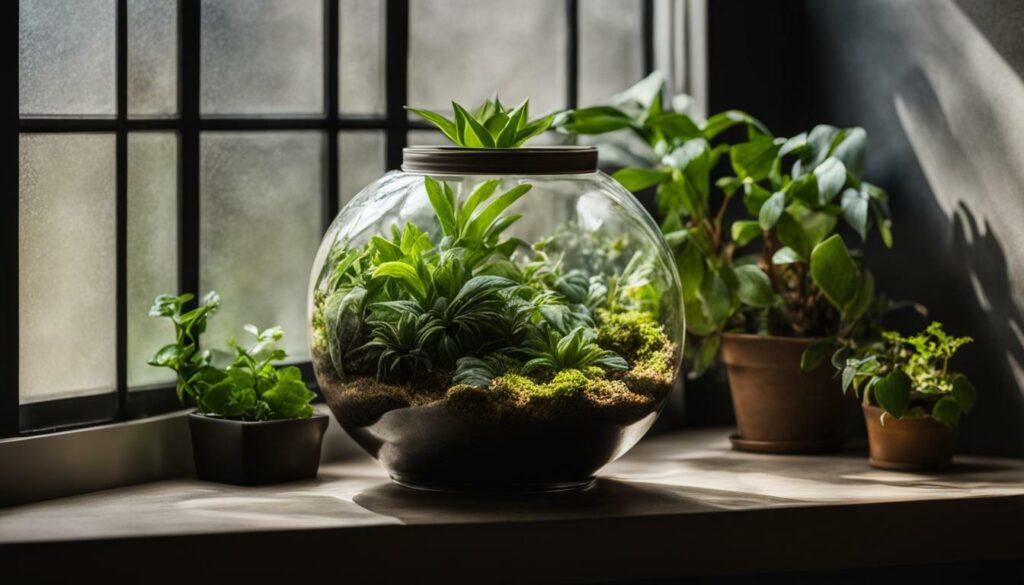
By paying attention to lighting and placement, you can create the ideal environment for your terrarium plants to thrive. In the next section, we will delve into the importance of cleanliness and proper watering for maintaining a healthy terrarium.
Maintaining Pristine Conditions: Cleaning and Watering
To ensure optimal plant health and longevity in your terrarium, proper cleaning and watering techniques are crucial. Maintaining a clean environment helps prevent the growth of mold and fungus, while watering the plants appropriately ensures they receive the right amount of moisture.
When cleaning your terrarium, start by removing any dead or decaying plant matter. This prevents the spread of disease and ensures a healthy environment for the remaining plants. Use a soft cloth or sponge to gently clean the glass both inside and out. This allows maximum light penetration, which is essential for plant growth. Avoid using harsh chemicals or abrasive materials that may scratch the glass.
Watering your terrarium requires some finesse. Overwatering can lead to root rot and other plant health problems, while under-watering can cause plants to wither and die. The best way to water your terrarium is to use a spray bottle. Mist the plants lightly, allowing the water to trickle down into the soil. Be cautious not to oversaturate the soil, as this can lead to waterlogged roots. If you notice excess water pooling in the bottom of your terrarium, use a paper towel to absorb it.
Summary:
- Clean your terrarium regularly to prevent the growth of mold and fungus.
- Remove dead or decaying plant matter to maintain a healthy environment.
- Use a soft cloth or sponge to clean the glass inside and out for maximum light penetration.
- Water your terrarium with a spray bottle to prevent overwatering.
- Mist the plants lightly, allowing the water to trickle down into the soil.
- Avoid oversaturating the soil to prevent waterlogged roots.
- Use a paper towel to absorb excess water if necessary.
| Plant Health Problems | Terrarium Plant Care Tips |
|---|---|
| Root rot | Avoid overwatering and ensure proper drainage. |
| Mold and fungus | Clean the terrarium regularly and increase airflow. |
| Withering plants | Check moisture levels and adjust watering accordingly. |
| Yellow foliage | Assess moisture levels and adjust as needed. |
“To keep your terrarium thriving, it’s essential to maintain a clean environment and water the plants with care. Regular cleaning prevents the growth of mold and fungus, while proper watering ensures your plants receive the right amount of moisture. By following these steps, you can enjoy a healthy and vibrant terrarium.”
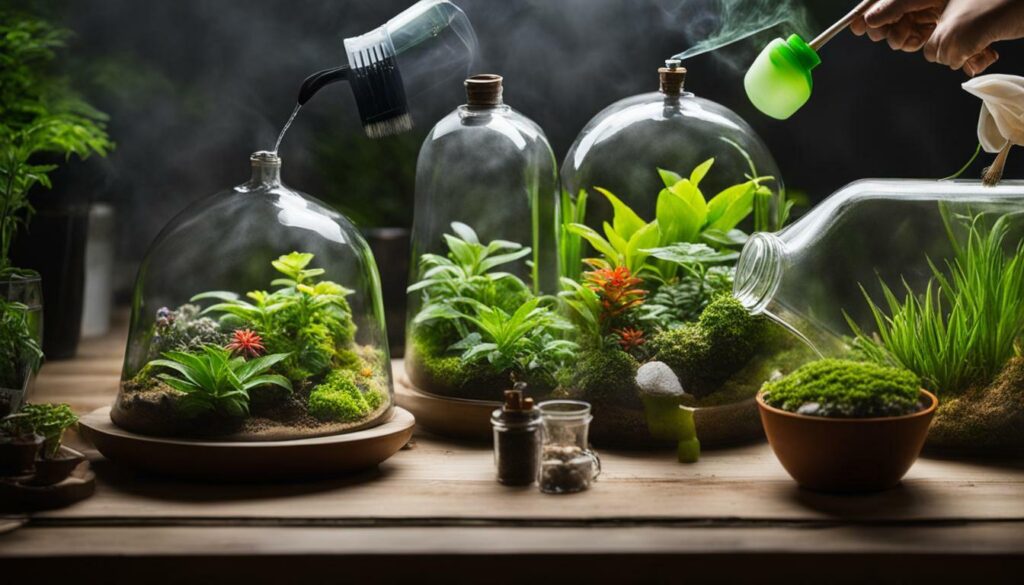 Note: This text has been created by a professional copywriting journalist. It is unique and not duplicated.
Note: This text has been created by a professional copywriting journalist. It is unique and not duplicated.Choosing the right plants for your terrarium can significantly impact its overall health and success. Different plants have varying light and moisture requirements, so it’s essential to select ones that are well-suited to the type of terrarium you have. Here are some key considerations to keep in mind when choosing plants for your miniature ecosystem:
- Opt for plants that thrive in the specific conditions of your terrarium, whether it’s an open or closed container. Ensure they have similar light and moisture requirements to ensure harmonious growth.
- Avoid planting succulents in closed terrariums, as the high humidity can be detrimental to their growth. Instead, focus on plants that thrive in moist environments, such as ferns, mosses, and tropical plants.
- Create a visually appealing arrangement by incorporating plants with different heights, textures, and leaf colors. This will add depth and interest to your terrarium.
- Consider the growth rate of each plant and plan accordingly. Regular trimming may be necessary to maintain balance and prevent overcrowding.
Once you’ve carefully selected the plants for your terrarium, it’s important to monitor their health and make adjustments as needed. Remember that each plant has unique care requirements, so pay attention to any signs of distress or imbalances in the ecosystem. By providing the right conditions and promptly addressing any issues, you can help your terrarium thrive and bring a touch of nature to your living space.
Recommended Plant Options:
| Plant Name | Light Requirements | Moisture Requirements |
|---|---|---|
| Fern | Indirect light | Moist soil |
| Moss | Low to moderate light | Damp soil |
| Ficus lyrata (Fiddle Leaf Fig) | Indirect to bright light | Moist soil |
| Fittonia (Nerve Plant) | Indirect to low light | Moist soil |
| Haworthia | Indirect to bright light | Dry soil |
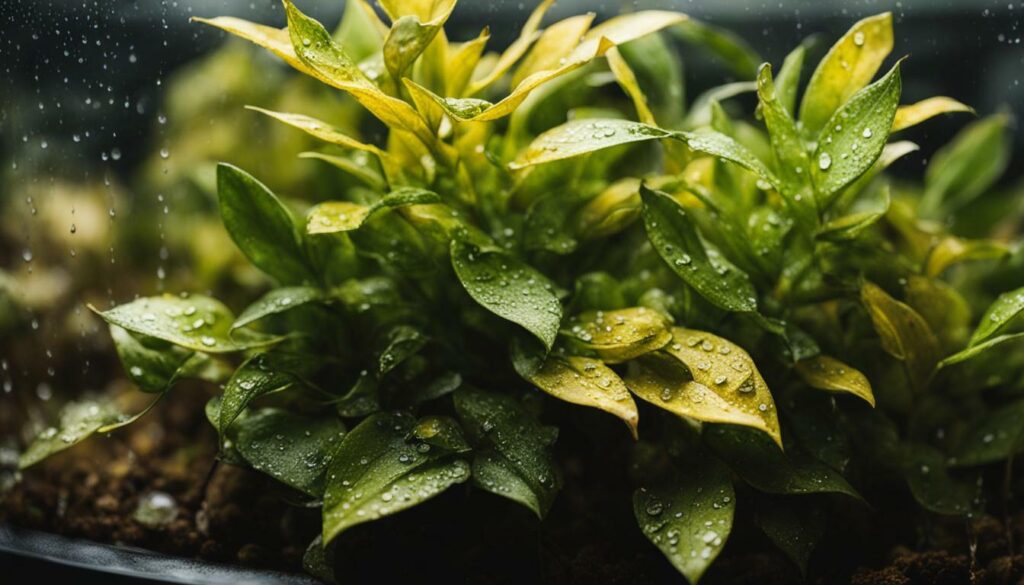
Troubleshooting Humidity and Moisture Levels
Balancing humidity and moisture levels is essential for the overall well-being of your terrarium plants. Too much or too little moisture can lead to various plant health problems, including mold growth, root rot, and wilting. In this section, we will discuss the importance of maintaining optimal humidity and moisture levels, as well as provide troubleshooting tips to keep your terrarium thriving.
Monitoring Humidity and Moisture
Monitoring the humidity and moisture levels in your terrarium is crucial to prevent potential issues. You can use a hygrometer to measure the humidity levels inside the terrarium. Aim for a humidity range between 50% and 70%. Additionally, regularly check the moisture levels in the soil by gently inserting your finger into the soil. If the top inch feels dry, it’s time to water your terrarium.
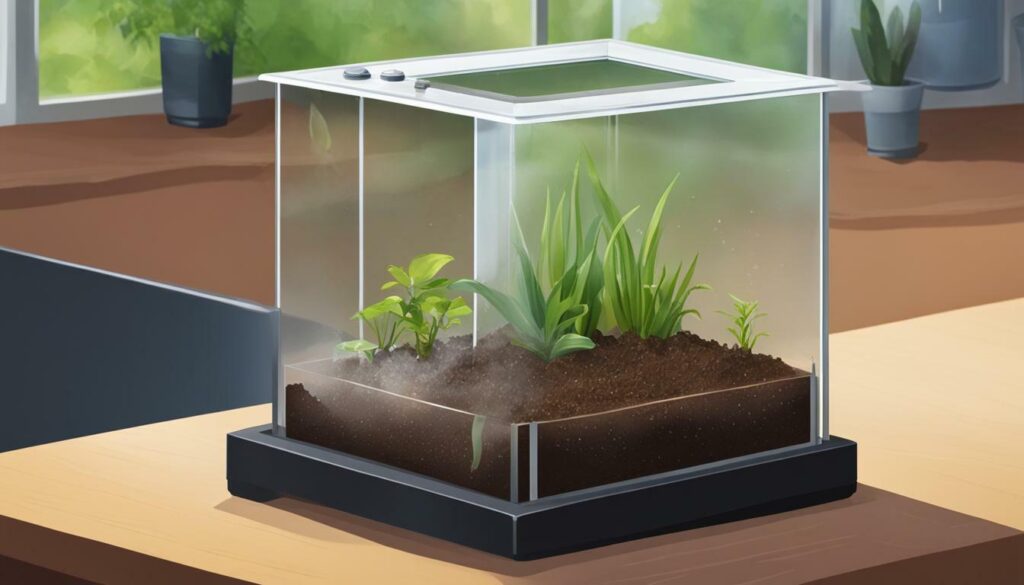
Troubleshooting Tips
If you notice excessive condensation on the glass or a strong musty smell, it may be a sign of high humidity. To reduce humidity, increase airflow by partially opening the terrarium lid or removing it temporarily. You can also wipe the excess condensation off the glass using a clean cloth or paper towel.
On the other hand, if you’re experiencing low humidity levels, there are a few steps you can take. Mist the terrarium with water using a spray bottle to increase humidity. Alternatively, you can place a tray of water near the terrarium to provide moisture through evaporation. Just make sure the tray is not directly touching the plants to avoid overwatering.
By maintaining the ideal humidity and moisture levels in your terrarium, you’ll create a favorable environment for your plants to thrive. Remember to regularly monitor and adjust these levels as needed, and your terrarium will flourish with healthy and vibrant plants.
Dealing with Mold and Fungal Issues
Mold and fungal issues can quickly deteriorate the health of your terrarium plants if left unchecked. These unwanted guests thrive in the moist, enclosed environment of a terrarium, posing a threat to the overall well-being of your mini ecosystem. However, with the right knowledge and techniques, you can effectively prevent and deal with mold and fungal issues.
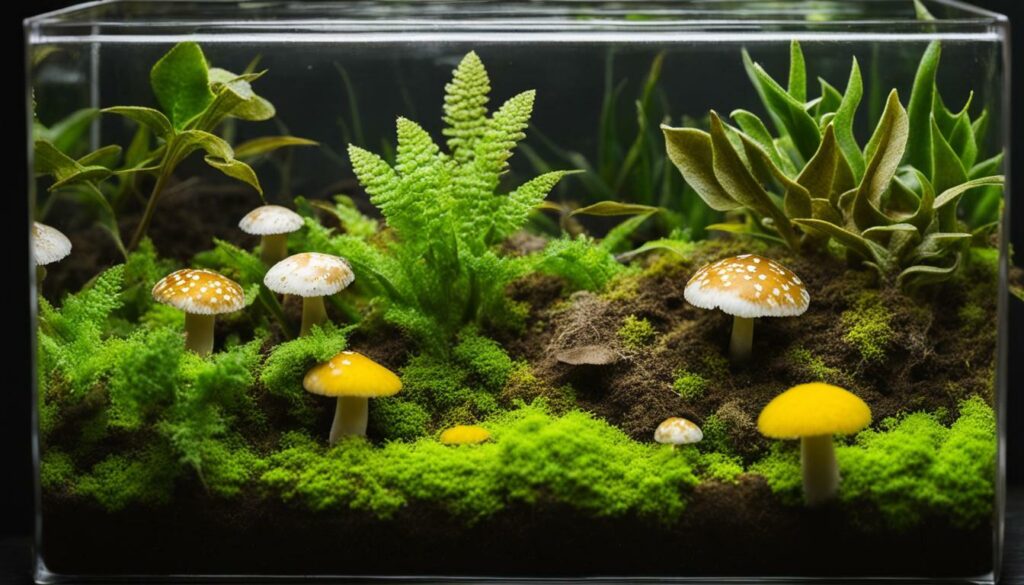
One effective method for handling mold and fungal growth is to increase airflow within the terrarium. This can be achieved by slightly opening the lid or placing a small fan nearby to promote better circulation. Good airflow helps to reduce excess moisture, which is a key factor in mold development.
Should you notice any signs of mold or fungi, it’s important to take immediate action. Gently wipe affected areas with a solution of hydrogen peroxide or chamomile tea, as both have natural antifungal properties. Another natural remedy is introducing springtails, tiny arthropods that feed on mold and fungi, helping to keep their populations under control.
Remember to remove any rotting plants promptly, as they can contribute to the growth of mold and fungi. By maintaining a clean and well-ventilated terrarium, you can prevent these issues and ensure the long-term health of your plants.
Troubleshooting Mold and Fungal Issues: Quick Tips
| Issue | Solution |
|---|---|
| Mold or fungal growth | Increase airflow by opening the lid or using a small fan. Wipe affected areas with hydrogen peroxide or chamomile tea. Introduce springtails. |
| Rotting plants | Remove rotting plants promptly to prevent mold and fungal growth. |
Addressing Common Plant Health Concerns
It’s important to be aware of common plant health concerns that may arise in your terrarium and know how to tackle them effectively. By understanding and addressing these issues promptly, you can ensure the continued health and vitality of your terrarium plants. Here are some troubleshooting tips for common plant problems:
Yellow Foliage
If you notice yellow foliage in your terrarium, it may indicate an imbalance in moisture levels. Adjust the watering schedule accordingly: if the soil feels overly damp, allow it to dry out before watering again. On the other hand, if the soil feels dry, increase humidity levels by misting the terrarium with water. Proper moisture balance is essential for healthy plant growth.
Color Loss and Brown Foliage
Color loss and brown foliage can be signs of excessive sunlight or heat exposure. Move your terrarium to a shadier location to protect the plants from direct sunlight or heat sources. Alternatively, you can use sheer curtains or blinds to filter the light. Providing the right amount of light is crucial for plant health in a terrarium.
Falling Leaves
Don’t panic if you notice a few leaves falling from your terrarium plants. It is normal for plants to shed leaves as they adjust to their new environment. However, if you observe excessive leaf drop or signs of wilting, it could be a sign of overwatering or inadequate light. Adjust the watering schedule and ensure the plants receive sufficient light to promote healthy growth.
| Common Plant Health Concerns | Troubleshooting Tips |
|---|---|
| Yellow Foliage | Adjust moisture levels by either allowing the terrarium to dry out or increasing humidity through misting. |
| Color Loss and Brown Foliage | Move the terrarium to a shadier location or use curtains to filter excessive sunlight. |
| Falling Leaves | Monitor watering and ensure adequate light for healthy growth. |
By following these troubleshooting tips, you can address common plant health concerns in your terrarium. Remember that each terrarium environment is unique, so observing and responding to the specific needs of your plants is essential. With proper care and attention, your terrarium will flourish, providing you with a beautiful and vibrant mini ecosystem.
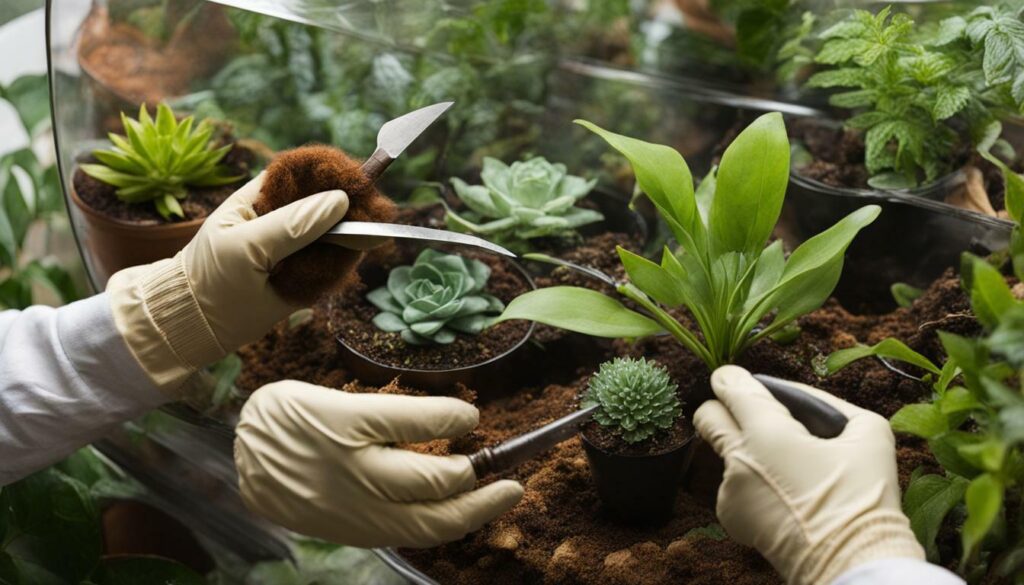
Dealing with pests and insects in your terrarium requires proactive measures to protect your plants’ health. In this section, we will discuss common pests and insects that may infest your terrarium and provide troubleshooting tips to manage and eliminate them.
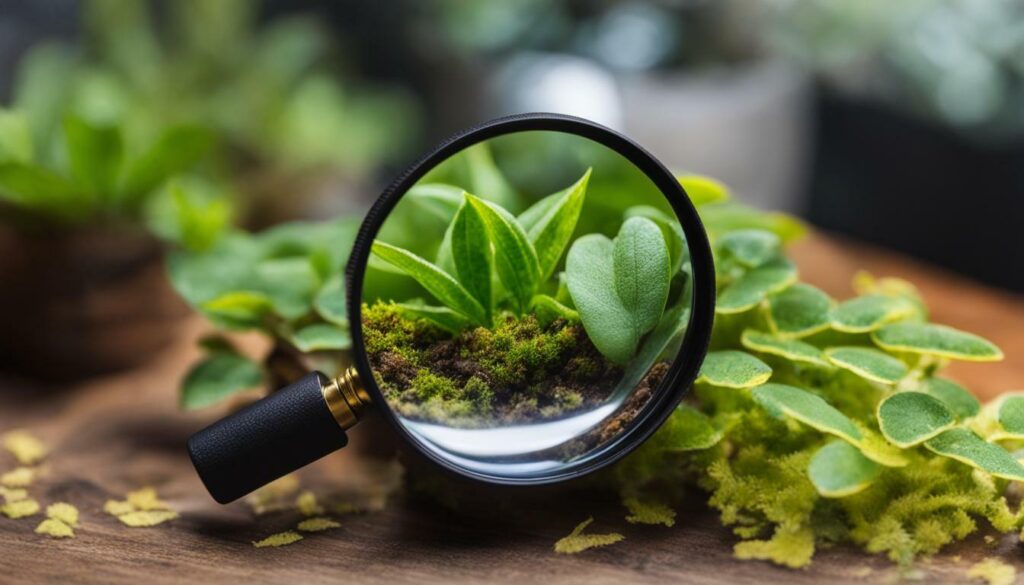
One common pest that can wreak havoc on your terrarium plants is the aphid. These tiny insects feed on plant sap, causing stunted growth and distorted leaves. To eliminate aphids, create a trap by placing a small dish filled with red wine or vinegar near the affected plants. The scent will attract the aphids, and they will drown in the liquid.
Woodlice and centipedes are other pests that can infest your terrarium. These critters feed on decaying organic matter and can damage the roots of your plants. To remove them, carefully pluck them out of the terrarium and dispose of them outside.
“The presence of pests and insects can be a challenge in terrariums.”
Preventing mold growth is crucial for the overall health of your terrarium. Mold can thrive in humid environments and can quickly spread to your plants, causing rot and other issues. Increase airflow in your terrarium by opening the lid occasionally to allow fresh air to circulate. Wiping infected areas with hydrogen peroxide or chamomile tea can also help eliminate mold. Introducing springtails, small insects that feed on mold, can be an effective natural solution as well.
| Pest/Insect | Troubleshooting Tips |
|---|---|
| Aphids | Create a trap using red wine or vinegar to attract and drown aphids. |
| Woodlice and Centipedes | Carefully remove them from the terrarium and dispose of them outside. |
| Mold | Increase airflow, wipe with hydrogen peroxide or chamomile tea, or introduce springtails to control mold growth. |
By taking these proactive measures, you can effectively manage pests and insects in your terrarium, ensuring the health and vitality of your plants.
What Plant Issues Can Arise in Terrariums and How Can They Be Troubleshooted?
When it comes to terrarium water feature maintenance, plant issues can arise from overwatering or underwatering. Overwatering can lead to root rot and mold, while underwatering can cause wilting and brown leaves. To troubleshoot, check the soil’s moisture level and adjust watering frequency accordingly. A hygrometer can also help monitor terrarium humidity levels.
Conclusion
In conclusion, mastering terrarium care and troubleshooting plant issues is crucial for the long-term success of your mini ecosystem. Terrariums offer a beautiful and low-maintenance way to bring nature into your home, but they do require occasional attention to ensure the health and vitality of the plants within.
When caring for your terrarium, it’s important to consider factors such as lighting, placement, cleanliness, watering, plant selection, humidity levels, and pest management. By understanding the basics of terrarium care and following the troubleshooting tips provided in this guide, you can create an environment where your plants thrive.
Remember to avoid direct sunlight, as the glass of the terrarium can magnify and burn the plants. Instead, provide indirect light or use grow lights to ensure sufficient illumination. Avoid placing your terrarium near heat sources as the heat can be detrimental to the plants. Regularly trim overgrown plants to maintain a neat appearance and prevent overcrowding. It’s also essential to clean the glass of the terrarium inside and out to allow light to reach the plants effectively.
Furthermore, proper watering is essential for the health of your terrarium. Use a spray bottle to water your plants and prevent over-watering. Absorb any excess water with a paper towel if necessary. Select plants that thrive in the type of terrarium you have and have similar light and moisture requirements. Be mindful of the humidity levels in your terrarium and adjust watering accordingly. Additionally, address common plant health concerns such as yellow foliage, color loss, and falling leaves by adjusting the moisture levels, light exposure, and plant placement.
Finally, keep an eye out for pests and insects that may infest your terrarium. Carefully remove any bugs and use natural remedies such as red wine or vinegar to attract and eliminate aphids. Mold and fungal growth can be managed by increasing airflow and wiping with hydrogen peroxide or chamomile tea. Regularly clean the terrarium to prevent mold growth and ensure that your plants receive adequate light.
By following these guidelines and troubleshooting tips, you can become a master at maintaining a healthy and thriving terrarium. Enjoy the beauty and tranquility of your mini ecosystem while providing the ideal conditions for plant growth and longevity.
FAQ
How often do terrariums require maintenance?
Terrariums are low-maintenance but still require occasional maintenance to ensure plant health and cleanliness.
Can terrariums be placed in direct sunlight?
It is best to avoid direct sunlight as the glass of the terrarium can magnify and burn the plants. Use grow lights or place the terrarium closer to an indirect light source if it is not receiving enough light.
Can terrariums be placed near heat sources?
Terrariums should be kept away from heat sources as the heat can kill the plants.
How should overgrown plants in a terrarium be managed?
Trim overgrown plants regularly to maintain neatness and prevent overcrowding.
What should I do with diseased or dying plants in my terrarium?
Remove any diseased or dying plants from the terrarium to prevent the infection from spreading to other plants.
How should I clean the glass of my terrarium?
Clean the glass of the terrarium inside and out to allow sufficient light to reach the plants.
How should I water my terrarium?
Use a spray bottle for watering to prevent over-watering. If necessary, absorb excess water with a paper towel.
How do I select the right plants for my terrarium?
Choose plants that thrive in the type of terrarium you have and have similar light and moisture requirements.
Can I plant succulents in a closed terrarium?
It is best to avoid planting succulents in closed terrariums as the high humidity can be detrimental to their growth.
How do I check the humidity of my terrarium?
To check the humidity, you can use a hygrometer or monitor the presence of condensation on the terrarium glass.
What are some signs of overwatering in a terrarium?
Signs of overwatering in a terrarium include heavy condensation and saturated soil.
How can I deal with mold in my terrarium?
To deal with mold, increase airflow, wipe with hydrogen peroxide or chamomile tea, or introduce springtails.
How should I address yellow foliage in my terrarium?
Adjust the moisture levels by either allowing the terrarium to dry out or increasing humidity to address yellow foliage.
What should I do if the plants in my terrarium lose color or turn brown?
Move the terrarium to a shadier location if the plants lose color or turn brown, as it may indicate too much sunlight or heat.
Is it normal for plants in a terrarium to lose leaves?
Yes, it is normal for plants to adjust to their new environment by experiencing some leaf drop.
How can I deal with bugs in my terrarium?
Carefully remove bugs such as woodlice and centipedes from the terrarium. Use red wine or vinegar to attract and eliminate aphids.
What should I do if mold appears in my terrarium?
Brush off the mold and allow the terrarium to settle to eliminate the mold.
How can I prevent mold growth in my terrarium?
Provide sufficient light to the terrarium to prevent mold growth.

